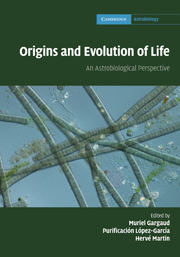Book contents
- Frontmatter
- Contents
- List of contributors
- Foreword
- Preface
- Part I What is life?
- Part II Astronomical and geophysical context of the emergence of life
- Part III The role of water in the emergence of life
- Part IV From non-living systems to life
- 16 Energetic constraints on prebiotic pathways: application to the emergence of translation
- 17 Comparative genomics and early cell evolution
- 18 Origin and evolution of metabolisms
- Part V Mechanisms for life evolution
- Part VI Life in extreme conditions
- Part VII Traces of life and biosignatures
- Part VIII Life elsewhere?
- Index
16 - Energetic constraints on prebiotic pathways: application to the emergence of translation
from Part IV - From non-living systems to life
Published online by Cambridge University Press: 04 February 2011
- Frontmatter
- Contents
- List of contributors
- Foreword
- Preface
- Part I What is life?
- Part II Astronomical and geophysical context of the emergence of life
- Part III The role of water in the emergence of life
- Part IV From non-living systems to life
- 16 Energetic constraints on prebiotic pathways: application to the emergence of translation
- 17 Comparative genomics and early cell evolution
- 18 Origin and evolution of metabolisms
- Part V Mechanisms for life evolution
- Part VI Life in extreme conditions
- Part VII Traces of life and biosignatures
- Part VIII Life elsewhere?
- Index
Summary
The origin of life, as with any other process of structure formation, should have been accompanied by a loss of entropy. Since the second law of thermodynamics states that the entropy of an isolated system tends to increase, any self-organizing system must exchange free energy (closed system) and/or matter (open system) with its environment in order that the overall entropy increases (Kondepudi and Prigogine, 1998). This simple observation emphasizes the importance of energy transfers in the origin and development of early life. As far as biochemical systems are concerned, energy exchanges mostly involve chemical energy that is brought about by ‘high-energy’ carriers so that energy flows through metabolic pathways from free energy-rich compounds towards low-energy molecules, the difference being released in the environment as heat. When the occurrence of a thermodynamically unfavourable reaction makes it necessary, fresh energy is provided to the system through coupled reactions involving a free-energy carrier such as ATP. The principle that energy is brought about by ‘high-energy’ carriers applies to most metabolic pathways, though some of them do not simply follow this rule. An example is the process of energy collection leading to ATP synthesis, in which ‘chemical’ energy is generated from a ‘physico–chemical’ source: a gradient of concentration between two compartments separated by the plasma–cell membrane (Mitchell, 1961).
- Type
- Chapter
- Information
- Origins and Evolution of LifeAn Astrobiological Perspective, pp. 247 - 258Publisher: Cambridge University PressPrint publication year: 2011
- 4
- Cited by



